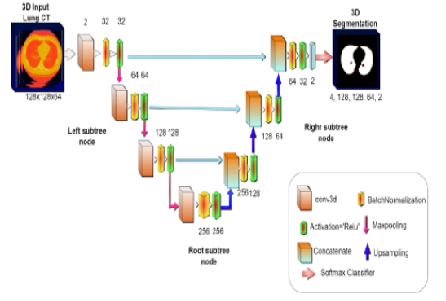


Indian Journal of Science and Technology
DOI: 10.17485/IJST/v17i13.2081
Year: 2024, Volume: 17, Issue: 13, Pages: 1368-1380
Original Article
P L Chithra1*, P Bhavani2
1Professor, Department of Computer Science, University of Madras, Chennai, 600025, TamilNadu, India
2Research Scholar, Department of Computer Science, University of Madras, Chennai, 600025, Tamil Nadu, India
*Corresponding Author
Email: [email protected]
Received Date:16 August 2023, Accepted Date:27 February 2024, Published Date:28 March 2024
Background/Objectives: A novel three-dimensional efficient Multi-Layer Convolutional Neural Network (3D-MLCNN) is proposed for detecting lung tumors accurately using Computerized Tomography (CT) lung tumor images. The proposed K-means segmentation algorithm for labeling the tumor region automatically. This proposed K-means segmentation algorithm automatically labels the tumor regions to process with the 3D MLCNN model to predict tiny tumors and extract tumor regions accurately. Methods: The proposed 3DMLCNN network goal is to extract the tumor region in CT lung images to classify the lung tumor volume by pixel-wise segmentation model. Findings: The proposed 3D MLCNN segmentation model for detecting the segmenting tumors produces outperforming results for predicting even tiny tumors in the lung images. Experimental results demonstrated with lung cancer CT images in TCIA datasets show that the proposed model 3D-MLCNN achieved a dice coefficient (9.6%), Intersection over Union (IoU) (80%), F1-Score (9.33%), Sensitivity (17.11%), and Accuracy (98%) respectively. However, the proposed model 3D MLCNN was evaluated and compared with the existing state-of-the-art segmentation methods, which shows a 10% improvement in the segmentation process. Novelty: A novel 3D MLCNN model enhances the tumor region and predicts the tumor accurately by labeling the tumor using K-means labeling techniques.
Keywords: 3D Convolutional Neural Networks, Lung Cancer CT Images, K - Means Labeling, Feature Visualization, Deep Learning
© 2024 Chithra & Bhavani. This is an open-access article distributed under the terms of the Creative Commons Attribution License, which permits unrestricted use, distribution, and reproduction in any medium, provided the original author and source are credited. Published By Indian Society for Education and Environment (iSee)
Subscribe now for latest articles and news.